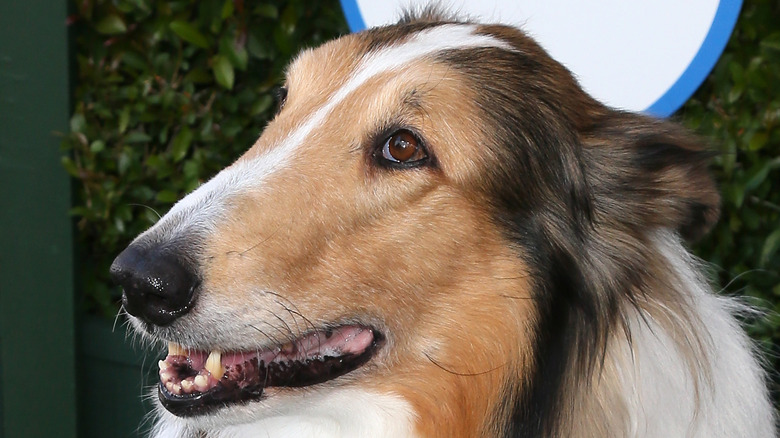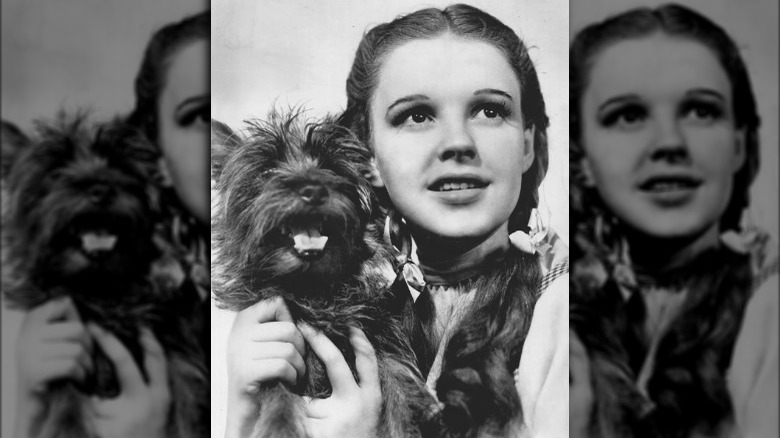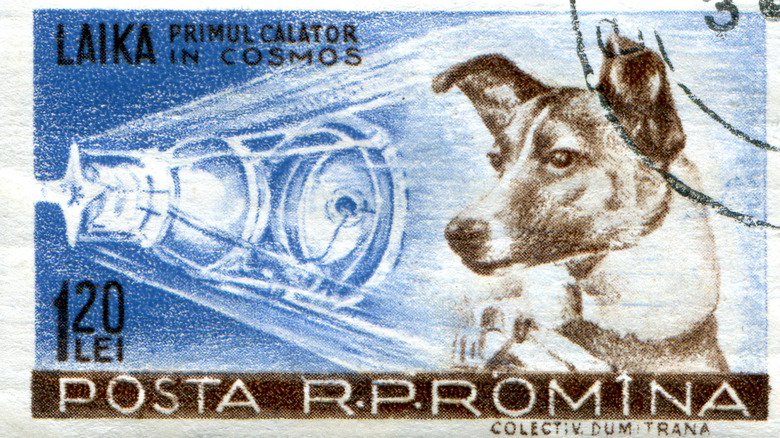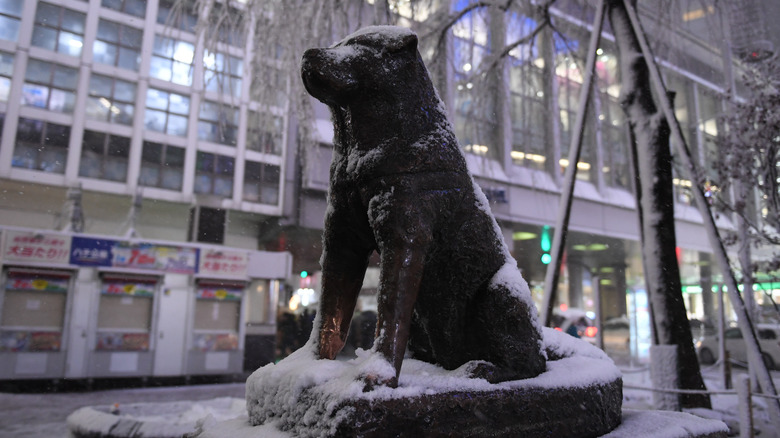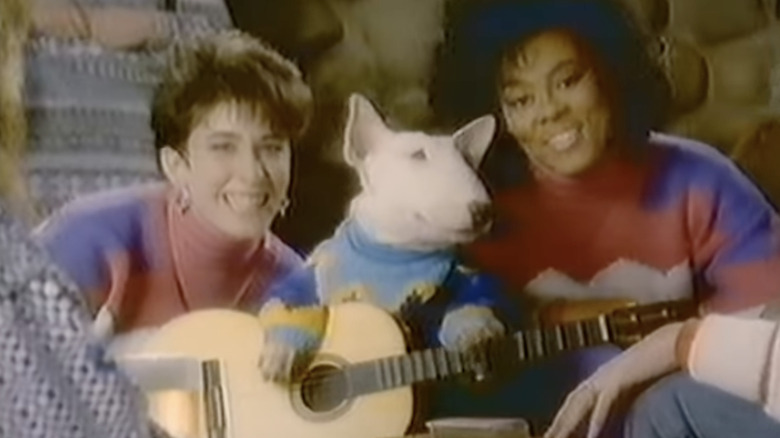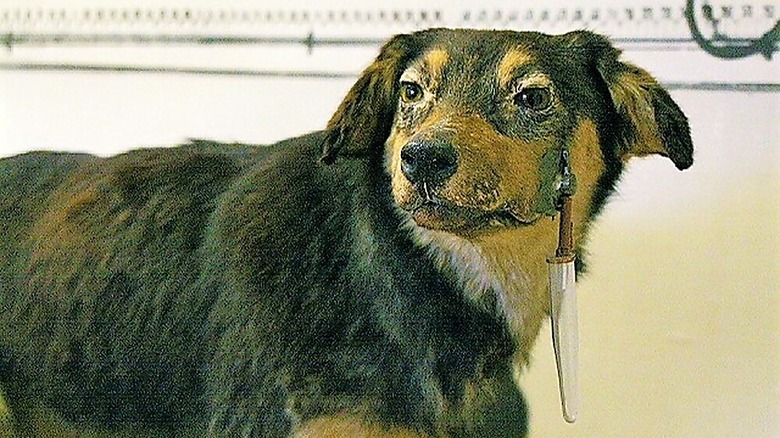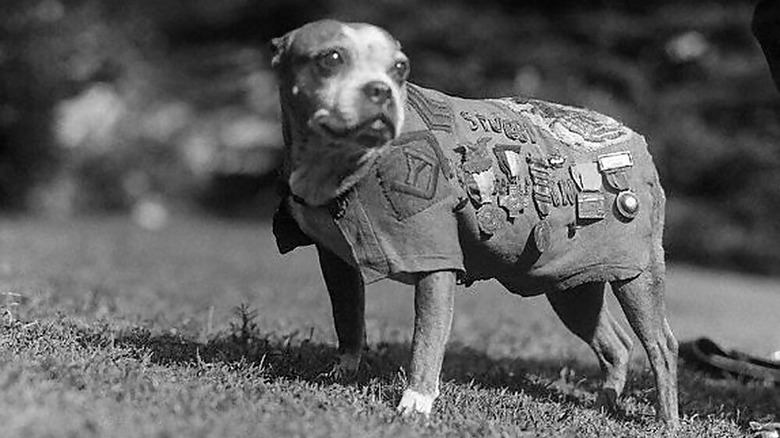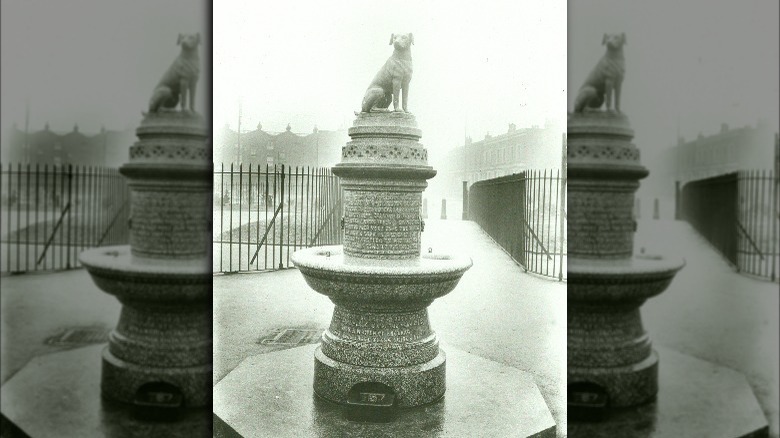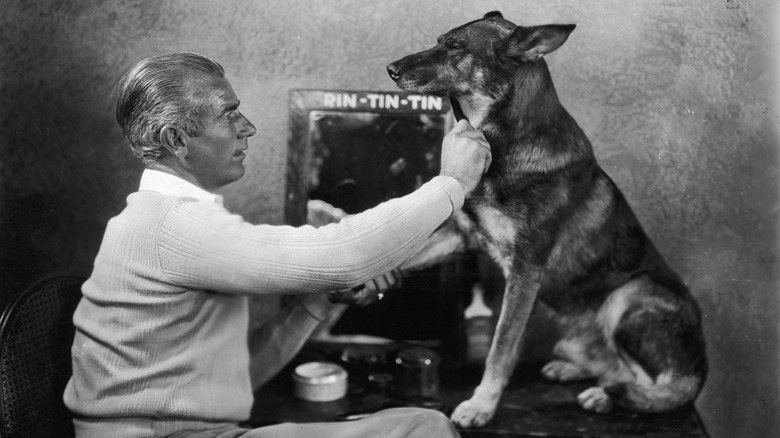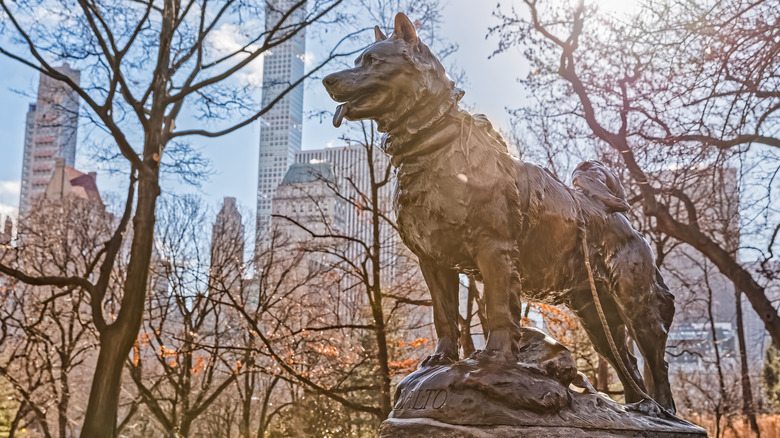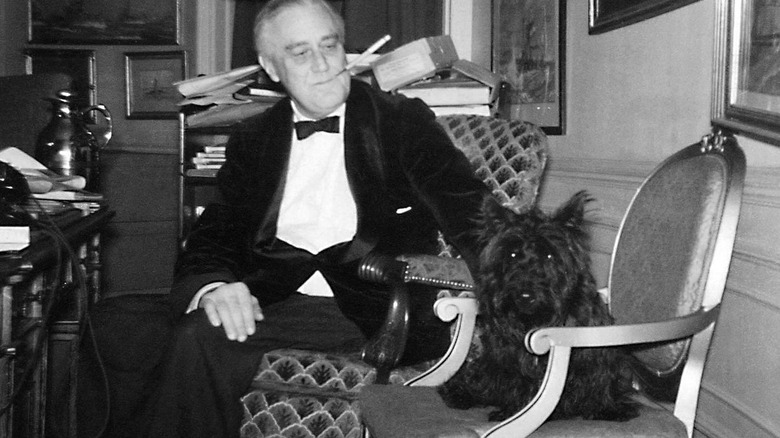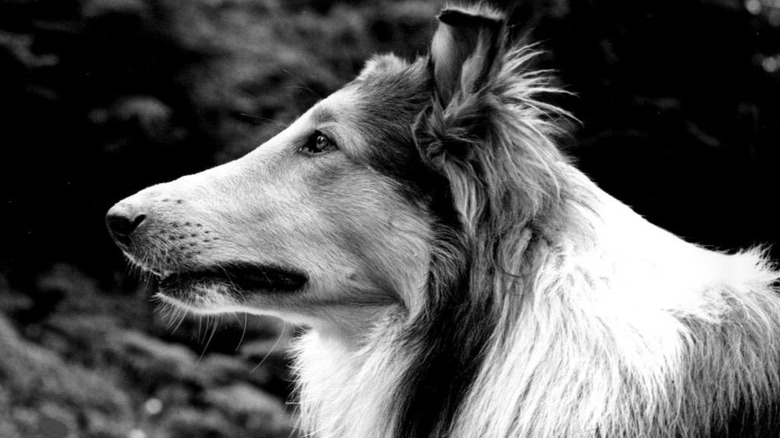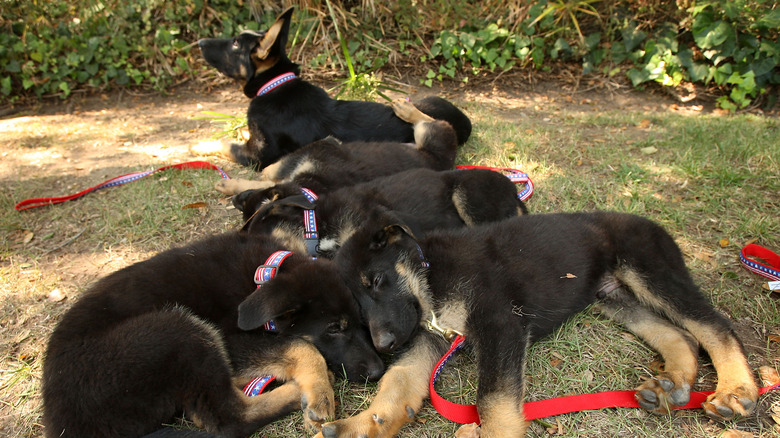The Most Famous Dogs In History
Few species have as close a bond as dogs and humans. As the BBC reports, dogs were domesticated at some point between 20,000 and 40,000 years ago — so it's no surprise that human history is full of contributions made by our canine companions. But which are the most famous dogs in history?
Set aside the famous fictional dogs like Snoopy, Kujo, and Scooby Doo, and instead focus on the real dogs that have made an impact. There have been all sorts of noteworthy dogs in history — from dogs who contributed to culture to pups who helped advance science, and from the famously loyal to the famously brave. Here are some dogs who are famous in their own right, as opposed to pooches that only rose to stardom on the coattails of their famous human owners. (No offense to the queen's corgis, of course.) This list is guaranteed to make you proud of your family dog — and even cat lovers are sure to crack a smile or two. Meet the most famous dogs in history.
Terry, the Cairn terrier who played Toto
If you had to pick just one pooch to award the title of most iconic dog in cinema history, you'd probably choose Toto from "The Wizard of Oz." That's partly due to the iconic nature of the film itself — its whimsical cast, music, and breakthrough use of Technicolor all contributed to "The Wizard of Oz" becoming the most viewed film of all time, per the Library of Congress. But Toto is also a memorable feature of the film, loyally following Dorothy on her journey through Oz and driving the plot forward (he helps reveal the wizard's true identity).
While the character of Toto was a male, he was played by a female Cairn terrier named Terry, according to NPR. Terry was born in 1933 and was owned and trained by German-American dog trainer Carl Spitz. When Terry was selected to play Toto in "The Wizard of Oz," she received a salary of $125 per week for her work on set. (Oddly enough, NPR reports that this was a higher salary than many of the human actors in the film received.) But Terry earned her pay, at one point suffering a sprained paw when it was accidentally stepped on.
Due to the popularity of "The Wizard of Oz," Terry had her name changed to Toto. After a few additional film performances, she died in 1944, but her legacy didn't stop there; her pup, Rommy, also had a film career.
Laika, the stray who became the first animal to orbit Earth
Few dogs have ever received as much global media attention as Laika. Laika came from humble beginnings — she was born a stray mutt on the streets of Moscow. But in 1957, according to Smithsonian Magazine, Laika became one of many female dogs taken off the streets by a team of researchers from the Soviet Space Program.
Researchers performed a number of tests to determine which dogs were the most docile and able to live in tight confinement. Eventually, they selected Kudryavka ("Little Curly") as their prime candidate, with Albina ("White") as her backup. When Kudryavka was introduced to the Soviet populace via radio, her barking led her to be popularly renamed "Laika," which roughly translates to "barker."
Just one month prior, the Soviet Union had stunned the world by launching the first artificial satellite, Sputnik 1. But now the Soviets wanted to send the first living creature into orbit. In the early hours of November 3, 1957, they succeeded. Laika was loaded onto the Sputnik 2 spacecraft, and successfully launched into low orbit.
But there was never any plan to bring Laika back to safety. Per the Smithsonian, an unexpected rise in temperature likely caused Laika to die from overheating just a handful of hours — and a handful of orbits — into her historic flight.
Hachikō, a Japanese Akita famous for his loyalty
Many communities have legends about particularly loyal dogs. In Montana, for example, there's Shep. As explained by FortBenton.com, Shep was a herding dog who was brought to Fort Benton when his master fell ill in 1936. That master died, and his body was shipped back east, but Shep would spend the next five-and-a-half years inspecting every person who got off the train in Fort Benton to see if it was his deceased master.
In India, a similar story is told about the dog Waghya. According to the Hindustan Times, Waghya was the pet dog of the Maratha king Shivaji. When Shivaji died in 1680, Waghya is said to have jumped on his owner's funeral pyre out of grief, immolating himself.
Perhaps the best known among famously loyal dogs is Hachikō, a Japanese Akita. As reported by AllThatsInteresting, Hachikō was acquired by Hidesaburō Ueno, a professor of agriculture at Tokyo Imperial University, in 1924. Every day, the pair would walk together from Ueno's home to Shibuya train station, and then from the station back home at 3 p.m. But in May 1925, Ueno suffered a fatal brain hemorrhage while teaching. For almost 10 years, Hachikō returned to Shibuya Station at 3 p.m. sharp each day in an effort to meet his master. By the time of his death from infection and cancer in March 1935, Hachikō had become famous across Japan for his loyalty.
Honey Tree Evil Eye, aka Budweiser mascot Spuds MacKenzie
Dogs have played a big role in advertising — and why wouldn't they? (Most) people love dogs, so if you can get the public to associate a dog with your product, they might start to love your product too. Taco Bell capitalized on this with its chihuahua ad campaign in the late 1990s, which included the dog's catchphrase, "Yo quiero Taco Bell!" According to CNN, that chihuahua was played by a dog named Gidget, who passed away in 2009 at the age of 15.
In the late 1980s, the most famous dog in advertising was Spuds MacKenzie, the bull terrier mascot for Bug Light. Spuds MacKenzie was a party dog, often portrayed wearing sunglasses and Hawaiian shirts, and always accompanied by a bottle of Bud Light. Spuds was often followed by a group of models known as the Spudettes. But, per Mental Floss, Spuds MacKenzie was actually played by a female bull terrier named Honey Tree Evil Eye — Evie for short. Evie's true gender was suppressed by Budweiser to maintain Spuds MacKenzie's macho image.
Laid-back Evie, with her distinctive brown eye spot, was the perfect candidate to portray Spuds, and the campaign was a success — Mental Floss even reports that Spuds helped drive up Bud Light sales by 20%. But public controversy — particularly around the notion that Spuds was being used to market beer to children — led to Anheuser-Busch retiring the character in 1989, after just two years in the spotlight. Evie died of kidney failure in 1993, aged 10.
The 40 dogs who advanced Ivan Pavlov's research
For hundreds of years, dogs have helped to advance science, often in the unpleasant role of test subject. Perhaps the best-known of these canine guinea pigs are the ones who were experimented upon by Russian physiologist Ivan Pavlov.
In the late 1800s, Pavlov was interested in studying the mechanics of digestion. To do so, he performed a number of experiments on dogs. It was from these digestive experiments that Pavlov ultimately stumbled onto the notion of classical conditioning. According to Simply Psychology, Pavlov expected that dogs would begin to salivate whenever food was placed in front of them. Instead, he found that his test dogs started salivating at the mere sound of the footsteps of the lab assistant who brought them their food each day.
Pavlov found that premature drooling didn't only occur at the sound of footsteps, but for any number of stimuli — from electric shocks to a ringing bell — that typically accompanied feeding time. From this, Pavlov developed the idea of classical conditioning, which Merriam-Webster defines as "conditioning in which the conditioned stimulus (such as the sound of a bell) is paired with and precedes the unconditioned stimulus (such as the sight of food) until the conditioned stimulus alone is sufficient to elicit the response (such as salivation in a dog)."
Current Biology reports that for his influential research, Pavlov relied on a subject group of about 40 dogs from a variety of breeds. Their names included Beck, Joy, Tungus, Milkah, Ruslan, and Murashka.
Stubby, the first dog given rank by the US Army
When you hear about Sgt. Stubby's accomplishments, it's hard to deny that he's worthy of his title. Per the Smithsonian's National Museum of American History, in 1917, Stubby was found wandering the grounds of Yale University, where the 102nd Infantry was training. The regiment adopted Stubby, and he quickly became their mascot, boosting morale with tricks like saluting with his paw. When the division shipped out for France, Pvt. J. Robert Conroy smuggled the dog onto their ship. Conroy's commanding officer discovered Stubby, but he allowed him to stay when the dog gave him a salute.
But Stubby's contributions weren't limited to simple tricks. In February 1918, Stubby followed the 102nd Infantry to the front lines, where he became acutely familiar with the smell of gas. One morning, while the soldiers were sleeping, Stubby smelled a gas attack and roused the regiment with barks and bites, likely saving their lives. Later, Stubby would help locate wounded soldiers on the battlefield. At one point, Stubby even helped his regiment capture a German spy, biting the German's legs and making him fall over.
For his contributions, Stubby was awarded the rank of sergeant, making him the first dog to be given rank in the United States Armed Forces, per the Smithsonian. In the years after World War I, Sergeant Stubby met several U.S. presidents and received many awards. He died in 1926, and his taxidermied corpse is held in the National Museum of American History.
The terrier who sparked the Brown Dog Affair
The Brown Dog Affair was a controversy that raged in Britain in the early 20th century. As explained by Encyclopedia Britannica, the controversy began in 1903, when a medical professor at University College London performed a vivisection on a brown terrier during a lecture demonstration. Several witnesses to the vivisection reported that the dog was conscious and suffering, having not been adequately anesthetized. Following the demonstration, the dog was handed off to a research student to be killed.
In response, in 1906, the National Anti-Vivisection Society unveiled a statue of a dog with a plaque inscribed "In Memory of the Brown Terrier Dog Done to Death in the Laboratories of University College." The statue was also dedicated to "the memory of the 232 dogs vivisected in the same place during the year 1902," and the plaque asked "Men and Women of England: How long shall these things be?"
Both medical professionals and students were opposed to the statue's anti-vivisection message, viewing vivisection as an essential practice for the advancement of medicine. So, on the night of November 19, 1907, a group of 500 men attempted to destroy the statue — but they were caught by the police and fined. Following their trial, outraged pro-vivisectionists marched in the streets of London, where they violently clashed with anti-vivisectionists in the so-called Brown Dog riots. Hoping to quell the controversy, the statue of the brown dog was removed by the local government in March 1910.
Rin Tin Tin, the silent film star
Rin Tin Tin may not be a household name today, but for a decade, he was the most famous dog in the world. As reported by War History Online, the German shepherd was discovered in 1918, when American soldier Lee Duncan came across a partly destroyed kennel on a World War I battlefield. There, Duncan found a starving mother and her litter of five puppies. He rescued them and nursed them back to health, keeping one male and one female puppy for himself. He named the female Nanette and the male Rin Tin Tin, after popular dolls that French children often gave to American soldiers.
Nanette died of pneumonia, but Rin Tin Tin would go on to have a historic career. Back in Los Angeles, Duncan taught Rin Tin Tin (nicknamed Rinty) some tricks, and entered him into dog shows. Eventually, Duncan realized that Rinty was good enough for Hollywood and landed him his first role in "The Man From Hell's River."
Warner Brothers and audiences fell in love with Rin Tin Tin, and he would go on to star in 27 films between 1922 and 1931. NPR reports that Rinty had a look that was "immensely expressive," which was a major asset during the silent film era. And Rin Tin Tin was no side character — in several of his films, like "Clash of the Wolves," Rinty had the starring role. Rin Tin Tin's death in 1932 was marked by an hour-long national broadcast remembering his life.
Balto, the sled dog who delivered life-saving vaccine doses
You've probably heard of the Siberian Husky named Balto — he's had a huge media legacy, most notably as the focus of Disney's 2005 animated film, "Balto."
As PBS explains, Balto is best remembered for his role in the 1925 serum run to Nome. In January 1925, the Alaskan town of Nome was struck by an outbreak of diphtheria, which put children and young people in particular at risk. Alaskan health officials realized that the nearest available antitoxin was across the state in Anchorage. Even worse, Anchorage's sole plane had been dismantled, as it was too cold to fly in the winter. So, the officials decided to ship the antitoxin north via train, then west across the state via a relay of 20 sled dog teams.
Balto is remembered for being the dog who led the final sled team to successfully deliver the antitoxin to Nome. However, as reported by the American Kennel Club, another dog, named Togo, played an even more central role in the relay. Togo led a team that traveled a total of 264 miles to Balto's 53 miles. But the public wanted a singular hero, and Balto quickly became a national celebrity. In 1927, per the Cleveland Museum of Natural History, Balto and six of his companions were bought by a businessman, and he spent the rest of his life in Cleveland's Brookside Zoo.
Fala, President Roosevelt's popular Scottish terrier
This is a dog who gained fame through his owner, but when a dog receives so much fan mail that they need to be given their own secretary, it's worth a mention.
This is referring to Fala, the Scottish terrier owned by President Franklin Delano Roosevelt. As reported by History, Fala followed his owner everywhere, from the Oval Office to official state visits with other world leaders. The White House kitchen staff even sent up a bone for Fala alongside Roosevelt's breakfast tray each morning.
Fala became something of an icon of the Roosevelt administration; the FDR Library reports that he received thousands of letters from the public, to the point where the dog needed his own secretary. But with success comes scrutiny. In 1944, critics accused Roosevelt of accidentally leaving Fala on the Aleutian Islands and sending a Navy destroyer to retrieve the dog at taxpayers' expense. Roosevelt had to give a public address defending himself and Fala against the allegation.
Fala was not the first "First Dog," but he was almost certainly the most popular. Due partly to Fala's popularity among the public, many American presidents since Roosevelt have chosen to continue the First Dog tradition. Most recently, this includes the Obama family's Portuguese Water Dog, Bo, and the Biden family's German shepherds, Champ and Major.
Pal, the Collie who played Lassie
Pal, a rough collie, was the first to portray Lassie. Similarly to Toto and Spuds MacKenzie, there was some gender-swapping here. Pal was a male, but portrayed a female collie on screen.
According to the book, "Lassie: A Dog's Life," Pal was bred at one of Hollywood's top kennels. However, Pal's large eyes and the (now iconic) white blaze on his forehead resulted in him being judged as a low-quality show dog, and so he was sold as a pet. Pal then passed hands between a few owners, as he proved difficult to train. But one owner, professional dog trainer Rudd Weatherwax, believed that Pal could be the perfect fit for the upcoming movie adaptation of the novel, "Lassie Come-Home."
But Pal was rejected yet again. MGM instead hired a female show collie to play Lassie, but Pal was kept on set to do stunts. However, while performing a stunt that involved swimming across a flooded river, Pal proved so impressive that he was immediately promoted to the role of Lassie. Not only that, but MGM decided to give the film a bigger budget and film it in full Technicolor. When "Lassie Come Home" came out, it was so popular that MGM turned Lassie into a full movie franchise, with Pal starring in six more Lassie films until his death. Several of Pal's descendants played Lassie through the years, including the current Lassie, who is a 10th-generation direct descendant.
Trakr, Barry, Zanjeer, and rescue dogs around the world
There are so many famous rescue dogs across the globe that it would be impossible to list them all individually. So, let's instead consider a few of the most notable examples.
First up is Barry, a Saint Bernard mountain rescue dog. According to SwissInfo, Barry saved the lives of 40 near-frozen people in the Swiss Alps throughout the early 1800s. It's also been said that Barry was killed by a soldier who mistook him for a wolf — but SwissInfo reports that Barry actually died of natural causes.
Next is Zanjeer, a Labrador retriever employed as a weapons/explosives detection dog with the Mumbai Police. Per the Better India, Zanjeer played a key role in detecting explosives during the 1993 Mumbai bombings, potentially saving hundreds of lives. When Zanjeer died of bone cancer in 2000, he was buried with full state honors and a lavish funeral.
But if you want a truly international hero, look no further than Trakr. Trakr was a German shepherd who was raised and trained in the Czech Republic before working for the police in Halifax, Canada. After the 9/11 terrorist attacks, Trakr's owner drove him to New York City to help look for wounded survivors in the rubble. According to ABC News, Trakr found the very last survivor on the morning of September 12. Trakr died in 2009, but that same year, he was selected by a biotech company to be cloned. The company produced the five puppies pictured, all sharing Trakr's exact DNA.
Kabosu, the Shiba Inu immortalized as Doge
Perhaps no dog today is as famous as Doge. No matter how you pronounce it (dohj? dohg? doggy?), you're no doubt familiar with the meme — a yellow-colored dog with a quizzical expression, often accompanied by broken English phrases in multicolored Comic Sans. As explained by KnowYourMeme, Doge first went viral in late 2013, quickly becoming one of the most popular memes on the internet. Unlike many other memes, however, Doge has been able to maintain its relevance over the years, re-emerging as an "ironic" meme a few years after its original popularity. More recently, Doge became the face of one of the most popular cryptocurrencies on the market — a currency made even more famous by promotion from billionaire Elon Musk, Forbes reports.
With all its popularity, it's easy to forget that there's a real dog behind the meme. That dog is Kabosu, a female Shiba Inu living with her owner, Atsuko Sato, in Japan. The Verge reports that Sato rescued Kabosu from an animal shelter in November 2008. Sato named the dog Kabosu after a Japanese fruit due to the Shiba Inu's round face. When Sato posted pictures of Kabosu to the internet in 2010, she had no idea how popular they'd become a few years later.
